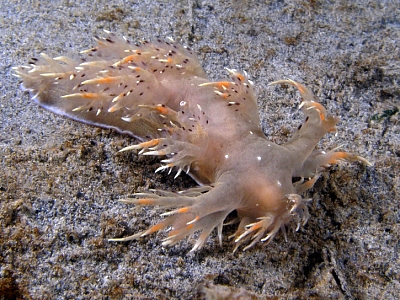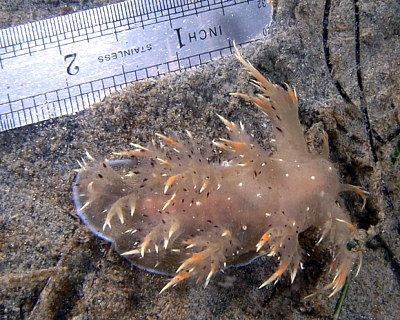Measuring nudibranchs
August 2, 2006
From: Kevin Lee

By the way, Doc...
Can you offer some advice on measuring opistobranchs? The attached photos show a Dendronotus iris, one with a stainless steel ruler next to the animal. Thus, the slug's "footprint" is approximately 2.5 inches long. Of course, these critters can elongate their bodies, when traversing territory. So is it best to measure "at rest" from front of the mantle to the end of the tail, or just the foot, or... is there any standard you recommend?
Locality: La Jolla Shores Canyon, near North Wall, 60fsw, California, USA, Eastern Pacific, 21 July 2006, Sandy bottom. Length: 2.5 inches. Photographer: Kevin Lee.
Thanks and good wishes,
K:-)
diverkevin@gmail.com
Kevin Lee, 2006 (Aug 2) Measuring nudibranchs. [Message in] Sea Slug Forum. Australian Museum, Sydney. Available from http://www.seaslugforum.net/find/17214
Dear Kevin,
We measure animals so we have a means of comparing sizes, growth, age etc. This is relatively simple when we are dealing with animals with backbones, or external skeletons or shells. All we need to do is choose two standard points on the body and we can get a measurement which can be compared by all researchers.
However, as you have noticed, we can never guarantee that two points on a nudibranch's body will be the same distance apart even after just a few minutes. Even an 'at rest length' or a 'crawling length' can be quite different depending on the substrate. For example, animals in a glass dish often elongate considerably more when they are crawling than they do on a natural substrate. Some authors in the past have tried to define standard points for us to use when measuring nudibranchs, but usually we measure them from the anterior tip of the head to the posterior tip of the foot. In some animals, like Stylocheilus longicauda, the posterior foot can extend into an extremely long thin filament, so whatever 'standard' measurement you make, it is always wise to explain just what you are measuring if there is likely to be any doubt.
The other problem is how accurate should measurements be? I have seen students attempting to measure in mm to 2 decimal places, which is quite absurd. The degree of error involved in measuring a crawling animal, with no fixed measuring points, makes such accuracy impossible and very misleading. I often use a pair of forceps, opening them to the length of the nudibranch, and then holding them open to that length by jamming my finger between the 'arms' until I can measure the 'length' on a nearby ruler or scale. A metal rule, as you have, is another way.
There is no accurate way to measure them, so the best we can aim at is a measurement which is generally comparable with other people's measurements. Of course if you are undertaking population or nutritional studies, and age and growth measurements are vital, then you would need to find a standard way to measure your material as accurately as possible. Many researchers have done this quite satisfactorily, but the way you do it needs to fit what is best and most efficient for that particular project.
For general observational records, a photo, with a head to tail length measurement is valuable. If there is a photo, it is clear whether the animal is at rest or crawling. And for accuracy - do the best you can, but as I have said above, attempts at precision are misguided. Even if you measure the slug to 3 or 4 decimal places, a second later it may stretch or contract by a third or even half its previous length!
Best wishes,
Bill Rudman
Related messages
-
Underwater Magnifying Lens
From: David Atkinson, February 1, 1999
